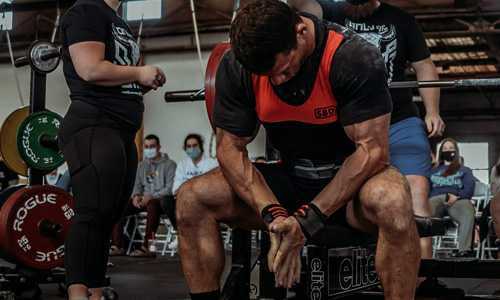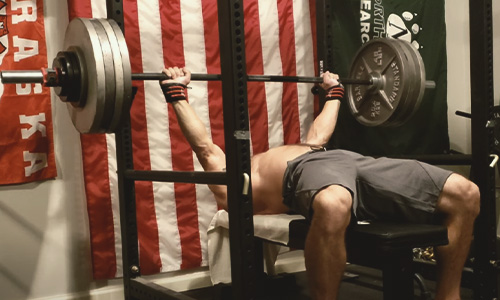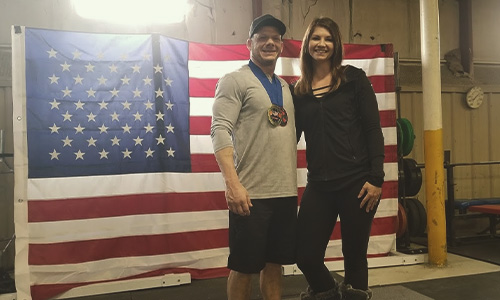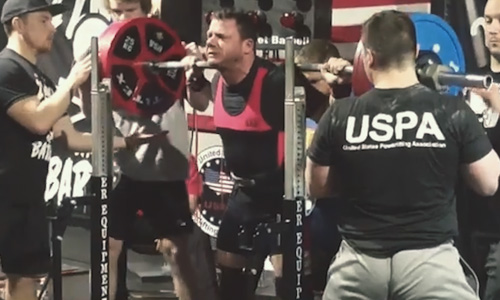So you have been training and have entered your first powerlifting meet, below is a guide I’ve created to help first time powerlifters and those lifters who are new to the sport. I compete primary in the USPA, so the technical rules are from the USPA rulebook. However, the general atmosphere, prep, and meet day fit almost all Federations.
- Equipment Required & Weigh-ins / Equipment Check (Raw only)
- Your Openers / Attempts
- The Warm-up Room / Area
- Staging Area
- Platform & Attempts
- Meet Day – What To Bring
Equipment Required & Weigh-ins / Equipment Check
Required Equipment
Here is a brief list of required and optional equipment. Please see the USPA Rulebook for exact rules and specs on each of the following.
- Singlet. All lifts
- Socks. For deadlift, one pair of knee-length socks must be worn. They must cover to the top of calf, ending just below the knee joint.
- Sleeve or Sleeveless T-shirt. Squat and bench t-shirt is required. It is optional for deadlift.
- Lifting Shoes or Boots. All lifts
- Underwear. Underwear is optional for all lifts, but it must be non-supportive and legless (tighty-whities)
- Sweat Bands/Headband (10 cm max width). No hats.
- Elbow Sleeves. May be worn in squat and deadlift, not exceeding 20 cm in length and 7 mm in thickness.
- Belt. The belt may have a buckle with one or two prongs, “quick release” type or ratchet style. Velcro is not allowed anywhere on the lifting belt. It shall not have additional padding, bracing or supports of any material on the surface or concealed within the laminations of the belt. Thickness of belt may be a maximum of 13 mm along the main length.
- Wrist Wraps. Wrist wraps may not exceed 1 m in length and 8 cm in width. Any sleeves, and Velcro patches/tabs for securing, must be incorporated within the one-meter length. A loop may be attached as an aid to securing. The loop shall not cover the thumb or fingers during the lift. See 2023 USPA Approved Gear List.
- Knee Sleeves (Raw). A one-ply knee sleeve or knee wrap made from commercially available neoprene or woven elastic that is covered with polyester, cotton or combinations of either materials of not more than 30 cm in length, and not exceeding 7mm in thickness. See 2023 USPA Approved Gear List.
- Knee Wraps (Classic Raw). Only knee wraps of one ply not exceeding 2.5 m in length and 8cm in width may be used. See 2023 USPA Approved Gear List.
Approved Equipment
The gear listed under each company is the only equipment permitted for use in a sanctioned USPA competition. These items include wrist wraps, knee wraps, knee sleeves, elbow sleeves, squat suits, bench shirts, deadlift suits, and briefs.
2023 USPA Approved Gear List
Weigh-ins
Equipment Check
Write-up coming soon.
Your Openers / Attempts
General Advice
If you have a coach, listen to him or her with your openers and attempts. If you are trying to determine openers and attempts on yourself here are a little guidelines that I’d suggest.
Openers
Do you lift with kg calibrated plates, squat, power, and deadlift bar on a combo rack or do you lift in more of a commercial type gym with pound plates on gym bars? If you lift in similar equipment to the meet, I’d suggest going with an opener in which you can easily hit for a double, possibly a triple on a below average day — especially in squat. Ensure you get your first lift on the board, get some nerves out, and learn commands. If you lift in a more of a commercial gym setting, I’d set those openers at a weight in which you can easily hit a triple. Don’t be afraid to change your openers on meet day through warm-ups. If you’re not feeling it that day, it’s better to lower the weight and get that opener in. The first squat of the day is by far the most nerve racking lift of the day. Missing it really hurts confidence.
NOTE: If you lift are a gym with the Hampton grip plates (45s are black with red handles) — those weight anywhere from 42 to 45 pounds, with most weighing 43 pounds. My first few meets, I couldn’t figure out why my bench was “15-20 pounds off” my gym max, it was because the 45s weighed light. My 440-450 gym bench was in actuality 425-435 lbs.
Attempts
If you have a coach, work with them on your attempts. If you are on your own, here are some suggestions, but work off a plan in which you can deviate on the fly as needed. Everyone has their own method of picking attempts, but here is what I do.
I create a Google Spreadsheet with 3 different weights for each attempt, a light, medium, and heavy. My seconds I usually try and match or be around my current meet PR (medium). I adjust based on how the previous attempt felt and looked in video. For my 3rds I pick a weight that matches my prep maxes. I like to pick weights in which I have hit in training. I know others like to pick 3rds above training maxes, but that isn’t my style.
The Warm-up Room / Area
General Courtesy
Every lifter in the warm-up room has the same right to warm-up as you do, please display common courtesy to other lifters. If you have a small warm-up area, limit those in your group and make sure every lifter warming-up has the space needed.
Suggestions
- When to start warming up. I’m older and need a longer time to warm-up and get mentally and physically ready. I start rolling, bands, stretching, etc. at least an hour before my squat flight starts (not when I lift). With my openers I’m usually last or towards the back of the flight, which gives me more time. A rule of thumb is a flight of 15 lifters will take 45 minutes in squat. I like to start when 2 flights in front of me is on second attempts. This isn’t loading up weight, but stretches, rolling, and bands. I don’t begin my weights until prior flight clears the area.
- Find yourself a group within your flight that has similar warm-up weights as yourself. Less removing and adding weight, the better for everyone. Allow everyone to work in when they ask. Also, don’t be afraid to ask others to work in with them. DO NOT GET INTIMATED AND CUT YOUR WARM-UP! If you have issues in warm-up area, alert the meet director immediately to address it.
- Don’t start using the weight until the previous flight is completed and left the area. With this, make sure you or someone cleans and puts away all weight before leaving the warm-up area.
- If applying baby powder for deadlifts, do so in a dedicated area or outside. At least a bare minimum do so standing over a towel not to make a mess.
- Have your warm-ups written out — in KGs. Makes it a lot easier. See the image below for what I do.
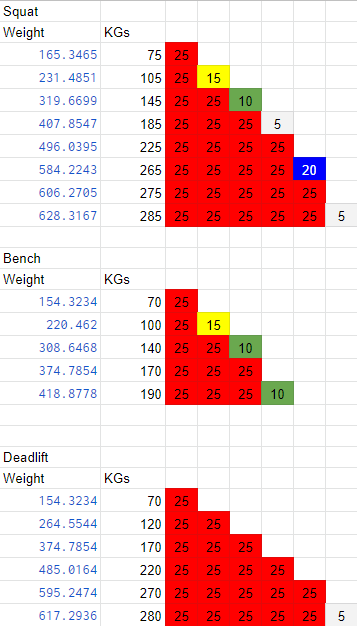
Staging Area
The staging area is the area in which lifters sit/stand and prepare for their attempts. This area is to one of the sides of the platform.
Suggestions
Again, be courteous to fellow lifters and allow them space and chairs. If space is limited, handlers and coaches might need to be elsewhere. I like to be out of the way and away from the action, so I setup near the back in a corner or out of the way. Just bring things you’ll need during flight and keep it to a minimum – smelling salts, wraps/sleeves, water/drink.
Platform & Attempts
After the weight is loaded and platform is ready, you have 1 minute to unload the bar off the rack. I HIGHLY SUGGEST taking at least 30 seconds of that minute. Everyone else in your flight will thank you. If you take 30 vs 10 seconds, on a flight of 15 lifters, that time adds up to 5 extra minutes between attempts. Your flight will take 15 minutes longer, but other lifters (like myself) high appreciate it.
Records
- Any new records set must exceed the previous record amount by at least 500 grams.
- The lifter and all lifting gear used were inspected prior to leaving the platform at the time of the lift.
- There must be three USPA certified State level or higher Referees judging any State record attempts, and at least two National or International Referees judging any National record attempts, and either three International, or two International and one National Referee judging any World Record attempts.
- Before stepping on the platform, a lifter must first notify the score table or expeditor and head referee that a new state, national or world record is being attempted to ensure that the correct credentialed referees are officiating the lift and the score card and scoring software are notated accordingly. Failure to notify the head referee and score table in advance will invalidate the record. Every time a lifter establishes a new record, they must have a complete gear check done immediately after the lift, just off the platform by a USPA official before walking away. This must include – knee sleeves verified by attempting to separate the material to demonstrate it is only one ply and the correct width, knee wraps verified by the lifter removing at least one wrap and the official holding it up to measure for all to witness, wrist wraps verified by the lifter removing at least one wrap and the official holding it up to measure for all to witness, belts either being removed, or the official runs their hand on the inside of the belt to verify no illegal support has been added, elbow sleeves verified by attempting to separate the material to demonstrate it is only one ply and the correct width, running the back of the hand below the crotch line on the side of the lifter, and on the side of the lifter above the navel area to verify no additional illegal support is hidden under the singlet, and in the case of a single ply bench shirt that the entire shirt is only one ply (some manufactures offer two ply sleeves on their one ply shirts), and a quick glance that nothing has been placed under the front of the shirt to shorten the lifters stroke. The singlet must also be checked to make sure it is only one ply and meets all other specs. A last-minute glance of the lifter from head to toe to verify that no other rule book violations are present that could invalidate the new record.
State Records
- You can compete in USPA in other states, however, you can only set State Records for the state in which your USPA Membership is registered.
- Example. I live in Nebraska and registered for the USPA in Nebraska. I can compete in a meet in Missouri, but only set Nebraska State Records.
National Records
- There must be at least two National or International Referees judging any National record attempts. Meet sign-up on the USPA Events page will indicate if National Records can be set.
Meet Day – What To Bring
- All Equipment – See Equipment Section. In addition to the required and optional equipment, I bring an extra belt lever and screwdriver.
- Smelling Salts.
- Chalk. Chalk is provided on the platform, but I bring my own for the warm-up area. Please be respectful and clean up any chalk in the warm-up area after you are finished.
- General First Aid. Super glue is a must in case of cuts on hands. Athletic tape.
- Folding Chair. For warm-up area.
- 2 Pairs of Headphones & Charger (for phone as well).
- Lots to drink. Electrolytes/Pedialyte is a must, and any pre-workouts, water, BCAAs, or any drinks that you like to consume, including post meet beers.
- Bands, Rollers, Massage Guns.
- Baby Powder (if desired for deads). Be courteous, apply outside or in a dedicated area.
